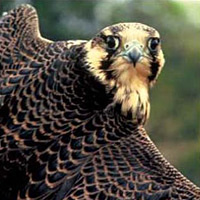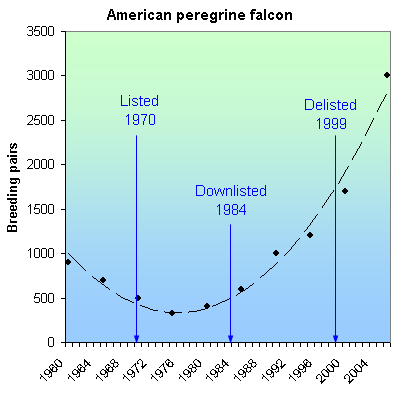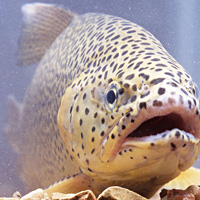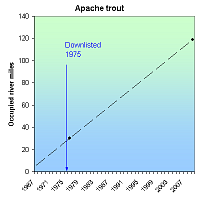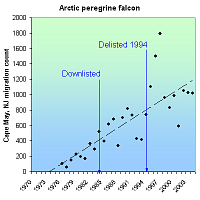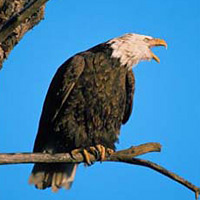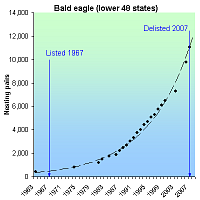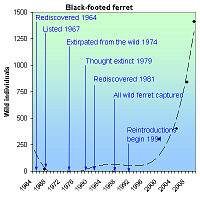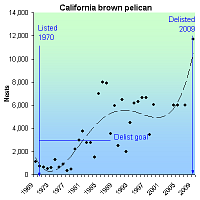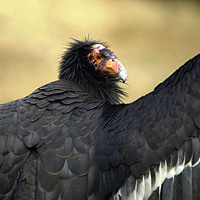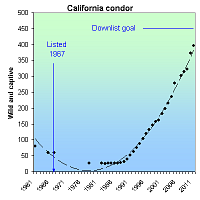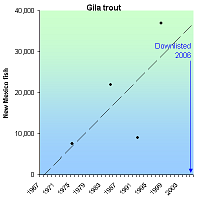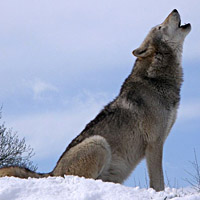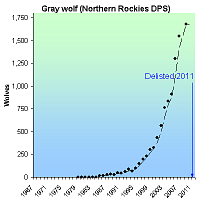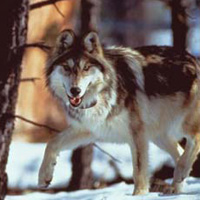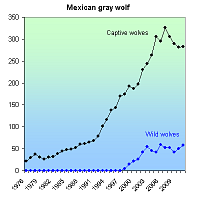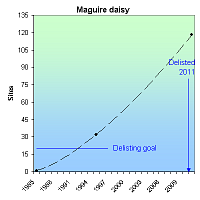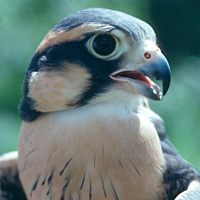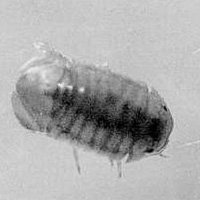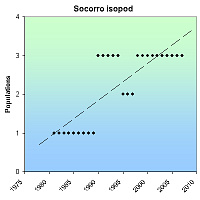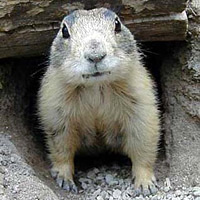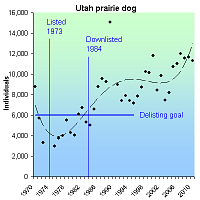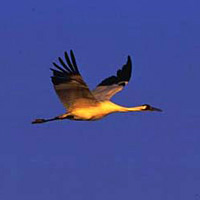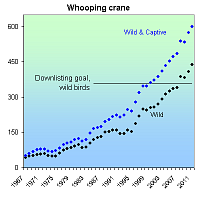American peregrine falcon (Falco peregrinus anatum)
| Status: Delisted | Critical habitat: 8/11/1977 |
| Listed: 6/2/1970 | Recovery plan: 6/30/1991 |
Range: AL(m), AK(b), AZ(b), AR(m), CA(b), CO(b), CT(b), DE(b), DC(m), GA(b), ID(b), IL(b), IN(b), IA(b), KS(m), KY(b), LA(m), ME(b), MD(b), MA(b), MI(b), MN(b), MS(m), MO(m), MT(b), NE(b), NV(b), NH(b), NY(b), NM(b), NJ(b), NC(b), ND(m), OH(b), OK(m), OR(b), PA(b), RI(b), SC(b), SD(b), TN(b), TX(b), UT(b), VT(b), VA(b), WA(b), WV(m), WI(b), WY(b) ---
SUMMARY
The use of DDT and other organochlorine pesticides thinned American peregrine falcon eggshells, causing reproductive failure and population declines. The banning of DDT, captive-breeding efforts and nest protections allowed falcons to increase from 324 breeding pairs in 1975 to 3,005 pairs as of 2006. The species was delisted in 1999.
RECOVERY TREND
The American peregrine falcon (Falco peregrinus anatum) breeds only in North and Central America and occurs throughout much of North America from the subarctic boreal forests of Alaska and Canada south to Mexico [1]. It is estimated that prior to the 1940s, there were approximately 3,875 nesting pairs of peregrines in North America [1]. From the 1940s through the 1960s, however, the population of the peregrine, and many other raptors, crashed as a result of the introduction of synthetic organochlorine pesticides to the environment. By 1975, there were only 324 known nesting pairs of American peregrine falcons in the U.S. [2].
Scientists investigating the peregrine's decline found unusually high concentrations of the pesticide DDT and its breakdown product DDE in peregrine falcons and other birds of prey [1]. Organochlorine pesticides were put into use following World War II. Use peaked in the late 1950s and early 1960s and continued through the early 1970s [1]. Organochlorine pesticides cause direct mortality and reduced reproduction in birds of prey because they ingest high doses of pesticides concentrated and stored in the fatty tissue of prey animals that themselves ingested contaminated food [1]. Heavily contaminated females may fail to lay eggs and organochlorines passed from the female to the egg can kill the embryo before it hatches [1]. DDE, the principal metabolite of DDT, prevents normal calcium deposition during eggshell formation, causing eggs to frequently break before hatching [1]. During the period of DDT use in North America, eggshell thinning and nesting failures were widespread in peregrine falcons, and in some areas, successful reproduction virtually ceased [1].
The degree of exposure to these pesticides varied among regions, and peregrine falcon numbers in more contaminated areas suffered greater declines [1]. The eastern population plunged from an estimated 350 active nest sites in the 1930s and 1940s to no active breeding birds from 1964 to 1975 [3]. Peregrine falcons in the Great Plains states east of the Rocky Mountains and south of U.S. and Canadian boreal forests were also essentially extirpated [1]. West of the 100th meridian, peregrine falcons were significantly reduced [1]. Local populations were greatly depressed or extirpated and by 1965 fewer than 20 pairs were known west of the U.S. Great Plains [1].
In 1970, the American peregrine was listed as endangered and efforts to recover the species began. The use of DDT was banned in Canada in 1970 and in the United States in 1972 [1]. This was the single-most significant action in the recovery of the peregrine falcon [1]. In addition, in the eastern United States, efforts were made to reestablish peregrine falcons by releasing offspring from a variety of wild stocks that were held in captivity by falconers [1]. The first experimental releases of captive-produced young occurred in 1974 and 1975 in the eastern United States [1]. These and future releases demonstrated that “hacking,” the practice of retaining and feeding young captive bred birds in partial captivity until they are able to fend for themselves, was an effective method of introducing captive-bred peregrines to the wild [1]. Since then, more than 6,000 falcons have been released in North America [1]. Approximately 3,400 peregrines were released in parts of southwest Canada, the northern Rocky Mountain States, and the Pacific Coast states [1].
In the late 1970s, Alaska became the first place American peregrine falcon population growth was documented and, by 1980, populations began to grow in other areas [1]. Not only did the number of peregrine falcons begin to increase, productivity (another important measure of population health) improved [1]. Efforts to reestablish peregrine falcons in the East and Midwest proved largely successful, leading to downlisting of the species in 1984 [1], and by 1999 peregrines were found to be nesting in all states within their historical range east of the 100th meridian, except for Rhode Island, West Virginia and Arkansas [1]. In highly urban areas, peregrine falcons showed great adaptability, and began substituting skyscrapers for natural cliff faces as nesting sites [4]. By 1998, the total known breeding population of peregrine falcons was 1,650 pairs in the United States and Canada, far exceeding the recovery goal of 456 pairs. Other recovery goals, including estimates of productivity, egg-shell thickness, and contaminants levels, had also been met, allowing the species to be delisted in 1999 [1]. Monitoring of American peregrine populations has continued under a post-delisitng monitoring plan [5]. The estimated North American population was 3,005 pairs as of 2006 [6].
ALASKA: Surveys conducted between 1966 and 1998 along the upper Yukon River demonstrated increases in the number of occupied nesting territories from a low of 11 known pairs in 1973 to 46 pairs in 1998 [1]. Similarly, along the upper Tanana River, the number of occupied nesting territories increased from two in 1975 to 33 in 1998 [1]. The recovery objective of 28 occupied nesting territories in the two study areas was first achieved in 1988, with 23 nesting territories on the Yukon River and 12 on the Tanana River [1].
PACIFIC STATES: By 1976, no American peregrine falcons were found at 14 historical nest sites in Washington [1]. Oregon had also lost most of its peregrine falcons and only one or two pairs remained on the California coast [1]. Surveys conducted from 1991 to 1998 indicated a steadily increasing number of American peregrine falcon pairs breeding in Washington, Oregon and Nevada [1]. Known pairs in Washington increased from 17 to 45 and in Oregon from 23 to 51 [1]. The number of American peregrine falcons in California increased from an estimated low of five to 10 breeding pairs in the early 1970s to a minimum of 167 occupied sites in 1998 [1]. The increase in California was concurrent with the restriction of DDT and included the release of more than 750 American peregrine falcons through 1997 [1].
ROCKY MOUNTAINS/SOUTHWEST: The Rocky Mountain/Southwest population of the American peregrine falcon has made a profound comeback since the late 1970s when surveys showed no occupied nest sites in Idaho, Montana or Wyoming and only a few pairs in Colorado, New Mexico and the Colorado Plateau, including parts of southern Utah and Arizona [1]. Surveys conducted from 1991 through 1998 indicated that the number of American peregrine falcon pairs in the Rocky Mountain/Southwest area has steadily increased [1]. In 1991, there were 367 known pairs; in 1998 the number of pairs increased to 535 [1].
EASTERN STATES: The eastern peregrine population has a unique history and complex status under the Act [1]. Peregrine falcons were extirpated in the eastern United States and southeastern Canada by the mid-1960s [1]. Releases of young captive bred peregrines have reestablished populations throughout much of their former range in the East [1]. In 1998, 193 pairs were counted in five designated eastern state recovery units [1]. The number of territorial pairs recorded in the eastern peregrine falcon recovery area increased an average of 10 percent annually between 1992 and 1998 [1]. Equally important, the productivity of these pairs during the same seven-year period averaged 1.5 young per pair, demonstrating sustained successful nesting [1].
CITATIONS
[1] U.S. Fish and Wildlife Service. 1999. Final Rule to Remove the American Peregrine Falcon from the Federal List of Endangered and Threatened Wildlife, and to Remove the Similarity of Appearance Provision for Free-Flying Peregrines in the Conterminous United States. Federal Register (64 FR 46542).
[2] Hoffman, C. 1999. The Peregrine Falcon is Back! New release, U.S. Fish and Wildlife Service, August 20, 1999.
[3] Clark, K. 2005. The Peregrine Falcon in New Jersey, Report for 2005. New Jersey Department of Environmental Protection, Division of Fish and Wildlife, Endangered and Nongame Species Program.
[4] New Jersey Division of Fish and Wildlife. Fact sheet, Peregrine Falcon Falco pereginus. New Jersey Department of Environmental Protection, Division of Fish and Wildlife, Endangered and Nongame Species Program. Website <http://www.njfishandwildlife.com/tandespp.htm> accessed February, 2006.
[5] U.S. Fish and Wildlife Service. 2003. Monitoring Plan for the American Peregrine Falcon, A Species Recovered Under the Endangered Species Act. U.S. Fish and Wildlife Service Division of Endangered Species and Migratory Birds and State Programs. Pacific Region, Portland Oregon 53pp.
[6] Green, M., T. Swem, M. Morin, R. Mesta, M. Klee, K. Hollar, R. Hazelwood, P. Delphey, R. Currie, and M. Aramal. 2006. Monitoring Results for Breeding American Peregrine Falcons (Falco peregrinus anatum), 2003. Biological Technical Publication BTP-R1005-2006. U.S. Department of Interior, Washington, D.C.
Apache trout (Oncorhynchus gilae apache)
| Status: Threatened | Critical habitat: 9/9/1977 | Listed: 9/9/1977 | Recovery plan: 6/23/1983 |
Range: AZ(b) ---
SUMMARY
Overfishing, habitat degradation and the stocking of nonnative salmonids reduced the Apache trout's range from 600 miles to fewer than 30 stream miles in 12 streams. Hybridization is an ongoing threat. Due to recovery efforts, the number of Apache trout has increased dramatically. As of 2010, there were 29 self-sustaining populations, nearing the goal of 30 populations outlined in the recovery plan.
RECOVERY TREND
The Apache trout (Oncorhynchus gilae apache) once occupied approximately 600 miles of stream habitat in the upper Salt River, San Francisco River, and Little Colorado River watersheds of Arizona [1]. By the 1940s it occupied fewer than 30 stream miles and occurred in only 12 streams on the Fort Apache Indian Reservation [1, 2]. Overfishing, habitat degradation and the stocking of nonnative salmonids (starting in 1920, stocking occurred in numerous streams supporting Apache trout) were the cause of this decline [3]. Today, due to recovery efforts, the number of Apache trout in remaining habitat has increased and the number of self-sustaining populations has increased [2]. The Apache trout is now present on the Apache-Sitgreaves, Coronado, and Kaibab national forests, on Fort Apache Reservation, on Arizona State’s Black River Lands, as well as on private land.
Management for Apache trout began in 1955 when the Fort Apache Indian tribe banned sportfishing on all streams containing known populations of Apache trout within the boundaries of the Mount Baldy Wilderness Area [4]. In 1963 the White Mountain Apache tribe, in collaboration with the U.S. Fish and Wildlife Service and Arizona Game and Fish Department, began a captive propagation program using fish taken from some of the 13 pure historic lineages of Apache trout found on the reservation [1]. Before captive bred fish were released, fish barriers were constructed on several streams to prevent upstream migration by exotic fish species [1]. The first stocking attempt occurred in 1965 into Mamie Creek [1]. Early stocking and renovation attempts were not always successful and sometimes hybrid stock were introduced [1]. By the 1970s, when the Apache trout was officially listed as threatened under the Endangered Species Act, introductions had been made into 12 streams, eight of which historically were known to support Apache trout. Releases at sites outside of the Apache trout’s historic range (e.g. streams in the Pinaleno Mountains and in North Canyon on the Kaibab plateau) were conducted in order to provide angling opportunities [1]. Since 1983, the Alchesay-Williams Creek National Fish Hatchery complex, located on the Fort Apache Indian Reservation, has produced several million Apache trout specifically for restoring sport fishery in streams while still maintaining the species' genetic integrity [2].
Restoration and reintroduction efforts have also taken place on federal land [2, 3]. On the Apache-Sitgreaves National Forest, the construction of barriers to exclude nonnative fish began in 1979 [3]. Barriers have been erected in at least 13 streams [3] and numerous streams have been stocked with Apache trout from the Alchesay-Williams Creek National Fish Hatchery [2]. Also, beginning in the 1980s, the exclusion of livestock from streams was initiated and 100 miles of stream on U.S. Forest Service lands were fenced to restore riparian and Apache trout habitat [3]. The species was downlisted from “endangered” to “threatened” in 1975 [8].
Currently, the largest concentrations of Apache trout occur on the Fort Apache Indian Reservation in the headwaters of the White and Black river drainages [5]. Some of the larger streams such as Bonita Creek and East Fork White River may carry several thousand Apache trout [5]. In addition to the Apache trout in streams, a stock population is maintained at the Alchesay-Williams Creek National Fish Hatchery [5]. In 2010 there were 32 populations of Apache trout, 29 of which were identified as self-sustaining [9]. This is approaching the recovery criteria of 30 self-sustaining populations outlined in the recovery plan [2].
Although Apache trout populations have increased, they still face the threats of habitat loss and degradation and genetic contamination. Nonnative trout continue to be stocked in Arizona streams [3]. Stocking of nonnatives undoubtedly limits the potential range expansion of Apache trout that still inhabits only a fraction of its former range [7].
CITATIONS
[1] U.S. Fish and Wildlife Service. 1983. Arizona Trout (Apache trout) Recovery Plan . Albuquerque, NM.
[2] Springer, C.L. 1999. Apache Trout: on the brink of recovery. Endangered Species Bulletin XXIV(4).
[3] Robinson, A. T., L. D. Avenetti, and C. Cantrell. 2004. Evaluation of Apache trout habitat protection actions. Arizona Game and Fish Department, Research Branch, Technical Guidance Bulletin No. 7, Phoenix. 19pp.
[4] Arizona Game and Fish Department. 2004. Apache trout chronology. Webpage <http://www.gf.state.az.us/w_c/apache_chronology.shtml> accessed April, 2006.
[5] U.S. Fish and Wildlife Service. Apache Trout Species Profile. Website accessed April, 2006.
[6] Arizona Game and Fish Department. Animal abstract, Apache Trout. Heritage Data Management System. Available at <http://www.azgfd.gov/w_c/edits/documents/Oncoapac.fo.pdf>.
[7] New Mexico Game and Fish. 2000. Apache Trout Species Account. Biota Information System of New Mexico BISON version 1/2000. Website <http://www.cnr.vt.edu/fishex/nmex_main/species/010582.htm> accessed April, 2006.
[8] U.S. Fish and Wildlife Service. 1975. Proposed Threatened Status for 3 Species of Trout (Lahontan cutthroat, Paiute cutthroat, Arizona trout, Salmo clarki henshawi, Salmo clarki seleniris, Salmo apache). 40 Fed. Reg. 17847.
[9] U.S. Fish and Wildlife Service. 2010. Apache trout (Oncorhynchus apache) 5-Year Review: Summary and Evaluation. Pinetop, Az. 8 pp.
Arctic peregrine falcon (Falco peregrinus tundrius)
| Status: Delisted | Critical habitat: none | Listed: 6/2/1970 | Recovery plan: 6/30/1991 |
Range: AL(m), AK(b), AZ(m), AR(m), CA(m), CO(m), CT(m), DE(m), DC(m), FL(m), GA(m), ID(m), IL(m), IN(m), IA(m), KS(m), KY(m), LA(m), ME(m), MD(m), MA(m), MI(m), MN(m), MS(m), MO(m), MT(m), NE(m), NV(m), NH(m), NY(m), NM(m), NJ(m), NC(m), ND(m), OH(m), OK(m), OR(m), PA(m), RI(m), SC(m), SD(m), TN(m), TX(m), UT(m), VT(m), VA(m), WA(m), WV(m), WI(m), WY(m) ---
SUMMARY
The Arctic peregrine falcon declined due to the egg shell-thinning effects of DDT and other organochlorine pesticides. Its listing as an endangered species in 1970 (along with other birds of prey) prompted the EPA to ban DDT in 1972. Counts of migratory Arctic falcons increased from 103 in 1976, to 1,017 in 2004. The species was downlisted to threatened in 1984 and delisted in 1991.
RECOVERY TREND
The Arctic peregrine falcon (Falco peregrinus tundrius) is one of three peregrine falcon subspecies [1]. It nests in tundra regions of Alaska, Canada (Yukon, Northwest Territories, Quebec, and possibly Labrador), and the ice-free perimeter of Greenland [1]. It is a long-distance migrant that winters in Latin America from Cuba and Mexico south through Central and South America [1].
Severe declines in peregrine falcon numbers began in the 1950s [1]. These declines were linked to organochlorine pesticides that were put into use following World War II, and whose use peaked in the late 1950s-early 1960s [1]. Scientists investigating the peregrine's decline found unusually high concentrations of the pesticide DDT and its breakdown product DDE in peregrine falcons and other birds of prey [2]. Organochlorine pesticides cause direct mortality and reduced reproduction in birds of prey which, being at the top of the food chain, ingest high doses of pesticides concentrated and stored in the fatty tissue of prey animals that themselves ingested contaminated food [1]. Heavily contaminated females may fail to lay eggs and organochlorines passed from the female to the egg can kill the embryo before it hatches. DDE, the principal metabolite of DDT, prevents normal calcium deposition during eggshell formation, causing eggs to frequently break before hatching [1]. Arctic peregrine numbers reached their lowest levels in the early 1970s and in some areas of North America successful reproduction virtually ceased [1]. Populations are thought to have decreased by as much as 80 percent [2].
The listing of the Arctic peregrine falcon as endangered in 1970--as well as the bald eagle, brown pelican, and American peregrine falcon shortly before--fostered a national outcry against the production and spaying of DDT. In 1972, the Environmental Protection Agency banned most used of DDT in the United States [1]. Canada had already restricted DDT use in 1970. These restrictions are the central cause of the recovery of the Arctic and American peregrine falcons (the bald eagle and brown pelican benefited greatly as well, but their recovery also involved substantial habitat protections and reintroductions).
As DDT levels declined after 1972, peregrine falcon productivity rates rose to pre-DDT levels and the population size and range began to increase. This happened most rapidly in northern areas, where pesticide exposur was lower and impacts upon populations were less severe [1]. In 1984, the U.S. Fish and Wildlife Service downlisted the Arctic peregrine falcon from endangered to threatened status [2, 6]. In 1991, the agency initiated a review determine if the species had recovered [2] and in 1994 removed it from the endangered species list [6].
Four major factors were considered in the delisting process: (1) Population size and trend, (2) reproductive performance, (3) pesticide residues in eggs, and (4) eggshell thickness [1]. Despite a lack of long-term studies using consistent methodologies, there was strong evidence of significant population increases throughout the Arctic [1]. Four areas in northern North America (one in Alaska and three in Canada’s North West Territories) for which historical survey information was available indicated the number of Arctic peregrine pairs occupying nesting territories increased since the 1960s [1]. Some areas of Alaska even exceeded the original estimates of pre-DDT-era population size [1]. In addition, in the eastern Arctic, peregrines began nesting in previously vacant nesting sites [1]. Standardized yearly migration counts at New Jersey’s Cape May, an area where Arctic peregrines concentrate during migration, also saw increasing numbers, most likely from Arctic breeding grounds especially in Greenland and eastern Canada (these counts may have also contained peregrines in the American subspecies; however, banding recoveries indicate that the majority of peregrines along the East Coast during fall migration are from the Arctic and thus represent a true increase in Arctic peregrine numbers) [1].
Productivity in all regions where data had been gathered was sufficient to support a stable or increasing population since the 1980s [1]. There had also been improvements in levels of DDE concentration in eggs. Concentrations in excess of 15-20 parts per million (wet weight basis) are associated with high rates of nesting failure. Residue in eggs in 1993 was well below this critical level [1]. Alaskan eggshells collected between 1988 to 1991 were on average only 12 percent thinner than pre-DDT thickness (17 percent or greater reduction in thickness results in population declines).
Arctic peregrine falcon numbers have continued to rise after the species' delisting. On the Sagavanirktok River in Alaska, where Arctic peregrine surveys have been conducted since the late 1950s, the number of pairs increased from five in 1958, to 23 in 1992, to 25 in 1999 [3]. Migration counts at the Cape May Hawkwatch site in New Jersey increased from 103 in 1976 to 1,024 in 2003 [4].
CITATIONS
[1] U.S. Fish and Wildlife Service. 1993. Proposal to Remove the Arctic Peregrine Falcon From the List of Endangered and Threatened Wildlife. 58 Fed. Reg 188.
[2] U.S. Fish and Wildlife Service. 1995. Peregrine falcon, (Falco peregrinus anatum, Falco peregrinus tundrius, Falco peregrinus pealei). Species account. Website <http://www.fws.gov/species/species_accounts/bio_pere.html> accessed October, 2005.
[3] Wright, J.M. and P.J. Bente. 1999. Documentation of active peregrine falcon nest sites, 1 Oct 1994- 31 March 1998. Alaska Department of Fish and Game. Annual research report. Endangered species conservation fund federal aid project SE-2-9, 10, and 11. Juneau, AK. 15 pp.
[4] Cape May Bird Observatory. 2012. Cape May Hawkwatch, Cape May, New Jersey. New Jersey Audubon Society. Website <http://www.njaudubon.org/Sightings/cmhw25.html> accessed April 2, 2012.
[5] NatureServe. 2011. NatureServe’s Central Databases. Arlington, VA. U.S.A
[6] U.S. Fish and Wildlife Service. 1994. Removal of Arctic Peregrine Falcon From the List of Endangered and Threatened Wildlife. 59 Fed. Reg. 50796.
Bald eagle (continental U.S. DPS) (Haliaeetus leucocephalus (Continental U.S. DPS))
| Status: Delisted | Critical habitat: none | Listed: 3/11/1967 | Recovery plan: 5/18/1999 |
Range: AL(b), AZ(b), AR(b), CA(b), CO(b), CT(b), DE(b), DC(b), FL(b), GA(b), ID(b), IL(b), IN(b), IA(b), KS(b), KY(b), LA(b), ME(b), MD(b), MA(b), MI(b), MN(b), MS(b), MO(b), MT(b), NE(b), NV(b), NH(b), NY(b), NM(b), NJ(b), NC(b), ND(b), OH(b), OK(b), OR(b), PA(b), RI(b), SC(b), SD(b), TN(b), TX(b), UT(b), VT(b), VA(b), WA(b), WV(b), WI(b), WY(b) ---
SUMMARY
The bald eagle declined throughout the lower 48 states, and was extirpate from most of them due to habitat loss, persecution, and DDT-related eggshell thinning. The banning of DDT, increased wetland protection and restoration, and an aggressive, mostly state-based reintroduction program caused eagle pairs to soar from 416 in 1963 to 11,052 in 2007 when the eagle was removed from the endangered list.
RECOVERY TREND
The bald eagle (Haliaeetus leucocephalus) first declined in the 1800s at the hands of trophy hunters, feather collectors, and wanton killing [1]. It was already extirpated or at low numbers in most states by the 1940s when DDT and other organochlorines became widely used. DDE, a breakdown product of DDT, accumulates in the fatty tissue of female eagles, impairing the formation of calcium needed for normal egg formation, causing a decline in reproductive success. DDT caused eagle numbers plummet further, and in 1967 the species was listed as endangered in the lower 48 states [1].
The eagle was joined on the list by the American peregrine falcon, Arctic peregrine falcon and brown pelican in 1970. The listing of these large, charismatic birds rallied the nation to band the production and sale of DDT in 1972.
Due to the DDT ban, increased habitat protection, and aggressive captive breeding and translocation programs (mostly run by state wildlife agencies), bald eagle pairs in the lower 48 soared from 416 in 1963 to 11,052 in 2007 when it was removed from the threatened species list [2, 7]. In 1984, 13 states lacked nesting eagles. By 1998, it was absent from only two. By 2006, it nested in all 48 states [7].
The eagle was proposed for delisting in 1998 [1] and again in 2006 [4]. It was downlisted in 1995 and delisted in 2007 [6].
The bald eagle is managed under five federal recovery plans, divided by region:
Chesapeake Recovery Region: Virginia east of Blue Ridge Mountains, Delaware, Maryland, the eastern half of Pennsylvania, West Virginia Panhandle and two-thirds of New Jersey. Delisting goals were met in 1996 [1]. As of 2003, there were more than 800 nesting pairs in this region [4].
Northern States Recovery Region: 25 Northernmost states. Delisting goals were met in 1991, with 1,349 occupied breeding areas across 20 states. As of 2007, there were an estimated 4,215 breeding pairs in the northern recovery region [6].
Pacific Recovery Region: Idaho, Nevada, California, Oregon, Washington, Montana and Wyoming. Numeric delisting goals were met in 1995 [1]. As of 2001, there were
1,627 nesting pairs in this recovery region [4].
Southeastern Recovery Region: Alabama, Arkansas, Florida, Georgia, Kentucky, Louisiana, Mississippi, North Carolina, South Carolina, Tennessee and eastern Texas. Downlisting goals were met between 1991 and 1998. More than 1,700 pairs were counted in 2000 [4, 6].
Southwestern Recovery Region: Oklahoma and Texas west of the 100th meridian, New Mexico, Arizona and California bordering the Lower Colorado River. The goal established in the recovery plan has been exceeded. In 2003, 46 occupied breeding areas were reported in New Mexico and Arizona. In 2004, the Arizona had 41 occupied breeding areas [4].
In the eight Northeast states from New Jersey to Maine and Vermont, nesting eagle pairs increased from 21 in 1967 to 562 in 2005 [5]. The majority were in Maine, which supported all 21 pairs in 1967 and 385 pairs in 2005. Eagles returned to Massachusetts and New Hampshire in 1990, with the former supporting 19 pairs in 2005 and the latter eight in 2004. In 2005 there were 53 pairs in New Jersey, 94 in New York and one in Vermont. The Northeast is also an important wintering area, with the Connecticut population increasing from 20 to 92 between 1979 and 2005, and the New York population increasing from six to 194 between 1978 and 2006 [5].
CITATIONS
[1] U.S. Fish and Wildlife Service. 1999. Proposed rule to remove the bald eagle in the Lower 48 states from the list of endangered and threatened wildlife. Federal Register, July 6, 1999 (64 FR 36453)
[2] U.S. Fish and Wildlife Service. 2007. Bald Eagle Numbers Soaring. May 14, 2007 press release.
[4] U.S. Fish and Wildlife Service. 2006. Removing the bald eagle in the Lower 48 States from the list of endangered and threatened wildlife; reopening of public comment period with new information. Federal Regiter, February 16, 2006 (71 FR 8238).
[5] Center for Biological Diversity. 2006. Bald eagle trends in the Northeastern United States. Tucson, AZ.
[6] U.S. Fish and Wildlife Service. 2007. Removing the Bald Eagle in the Lower 48 States From the List of Endangered and Threatened Wildlife; Final Rule. 72 Fed. Reg 37346.
[7] Suckling, K. and W. Hodges. Status of the bald eagle in the lower 48 states and the District of Columbia: 1963-2007. Center for Biological Diversity, Tucson, AZ. Available at http://www.biologicaldiversity.org/species/birds/bald_eagle/report/index.html.
Black-footed ferret (Mustela nigripes)
| Status: Endangered | Critical habitat: none | Listed: 3/11/1967 | Recovery plan: 8/8/1988 |
Range: AZ(b), CO(b), MT(b), SD(b), UT(b), WY(b) --- KS(x), NE(x), NM(x), ND(x), OK(x), TX(x)
SUMMARY
The black-footed ferret was nearly driven extinct due to the elimination of prairie dog colonies by habitat destruction, shooting and plague. It was thought extinct until 1964, extirpated from the wild in 1974, thought extinct again in 1979, then rediscovered in 1981. All ferrets were captured in 1987. A reintroduction program increased wild ferrets from 0 in 1991 to about 1,410 in 2010.
RECOVERY TREND
The black-footed ferret (Mustela nigripes), which once occurred throughout the grasslands and basins of interior North America, from southern Canada to Texas, is entirely dependent upon prairie dog colonies [1]. It lives in prairie dog burrows and hunts prairie dogs for food. Its historical range is nearly identical to that of three prairie dog species-- the black-tailed prairie dog, Gunnison's prairie dog and white-tailed prairie dog.
Prairie dogs were formerly abundant and may have supported as many as 5.6 million black-footed ferrets in the late 1800s [2]. They declined precipitously due to conversion of grasslands to agriculture and development, killing for sport, and large-scale poisoning to eliminate reduction in livestock and agriculture industry profits. Prairie dogs are now absent from an estimated 90 to 95 percent of their historically occupied area.
Ferrets declined in parallel to prairie dogs [1]. Of the approximately 130 counties and provinces where ferrets were found since 1880, only 10 were known to have ferrets by the 1960s [1]. In 1971, six ferrets were caught and removed from a declining population in South Dakota in a first effort at captive breeding. The effort was unsuccessful and the last captive ferret died in 1979. Following this loss, the black-footed ferret was thought to be extinct throughout North America.
In 1981 a tiny, relic population was discovered in a prairie dog colony near Meeteetse, Wyoming [1]. The population declined, so to avert the ferret's extinction, all remaining animals were brought into captivity in 1987. These ferrets are the founders of all subsequent reintroductions.
As of 2008, ferrets had been reintroduced to 18 sites [2]. There were 838 wild ferrets and 422 wild adults which is 28 percent of the recovery plan's goal of 1,500 adult ferrets [2]. In early 2010, the Fish and Wildlife Service estimated that it had reached 47 percent of the goal, which would put the adult population at about 705 and the total population at about 1,410 [3].
CITATIONS
[1] U.S. Fish and Wildlife Service. 1988. Black-footed Ferret Recovery plan. Denver, Co. 154pp. http://ecos.fws.gov/docs/recovery_plans/1988/880808.pdf
[2] U.S. Fish and Wildlife Service. 2008. Black-footed ferret 5-Year review, summary and evaluation. Pierre, S.D. 38 pp. https://ecos.fws.gov/docs/five_year_review/doc2364.pdf
[3] U.S. Fish and Wildlife Service. 2012. Black-Footed ferret. Website http://www.fws.gov/mountain-prairie/species/mammals/blackfootedferret. Accessed May 10, 2012.
[4] Matchett, R. 2006. Personal communication with Randy Matchett, U.S. Fish and Wildlife Service Senior Biologist, Charles M. Russell National Wildlife Refuge, April 16, 2006.
California brown pelican (Pelecanus occidentalis californicus )
| Status: Delisted | Critical habitat: none | Listed: 10/13/1970 | Recovery plan: 2/3/1983 |
Range: AZ(o), CA(b), OR(s), WA(s) ---
SUMMARY
The California brown pelican declined due to habitat loss, reproductive failure from DDT-related eggshell thinning and toxic exposure to the pesticide endrin. It was listed as endangered in 1970, but continued declining to a low of 466 pairs in 1978. Since then, it as increased, though inconsistently, reaching 11,695 nesting pairs when delisted in 2009. The banning of DDT and protection of nesting areas, especially in Channel Islands National Park, are responsible for its recovery.
RECOVERY TREND
The California brown pelican’s (Pelecanus occidentalis californicus) breeding range extends from California's Channel Islands south along the Pacific coast to Baja California, eastward throughout most of the Gulf of California, and southward along the mainland Pacific coast of Mexico to Islas Tres Maria [1]. It formerly bred as far north as Point Lobos in Monterey County. Currently, U.S. nesting colonies are located on West Anacapa and Santa Barbara islands of the California Channel Islands. The nesting range recently expanded to the Salton Sea [1]. As non-breeders, pelicans occur from southern British Columbia to El Salvador and inland in the U.S. to Southern California and Arizona.
The California nesting population declined from 1,125 to 727 annual nests between 1969 and 1970 when the species was placed on the list of endangered species [1]. The primary cause of decline was exposure to the pesticides endrin, which caused pelican mortality, and DDT, which caused egg-shell thinning. The Channel Island population was particularly impacted by a single Los Angeles factory which began discharging 200 to 500 kilograms of DDT daily in 1952.
DDT was banned in 1972, in large part because of the endangered species listing of the pelican, bald eagle and peregrine falcon. Following the ban, the pelican’s reproductive success began to improve quickly, although breeding effort did not show significant improvement until the early 1980s [3]. With the exception of a good year in 1974, the number of nests remained at low levels through 1978 when a low of 466 nests was recorded. Between 1979 and 1987, the population rose rapidly to 7,900 nests. Between 1987 and 2004, the number of nests fluctuated around a mean of about 5,000 nests. The 2004 nest count was about 7,500 (6,000 on West Anacapa and 1,500 on Santa Barbara Island). The 2006 nest count was about 9,000 with nesting on all three Anacapa islands (4,000 to 5,000), Santa Barbara Island (4,000) and Prince Island (43) [5]. 2006 was the first year since monitoring began that breeding occurred on all three Anacapa islands and the first time since 1939 that breeding occurred on Prince Island. In 1996, a small population of pelicans began nesting in the Salton Sea and has been present in most years since.
The California brown pelican was delisted in 2009 due to recovery, at which time there were 11,695 nesting pairs [7].
CITATIONS
[1] Shields, M. 2002. Brown Pelican (Pelecanus occidentalis). In The Birds of North America, No. 609 (A. Poole and F. Gill, eds.). The Birds of North America, Inc., Philadelphia, PA.
[2] Rogers, T. 2004. Spate of juvenile deaths follows breeding success. San Diego Union Tribune, August 1, 2004.
[3] Harrison, S.C. 2005. Petition to Delist the California Brown Pelican From the Listed of Endangered or Threatened Species Under the Endangered Species Act. Hunton & Williams, Washington, D.C., December 14, 2005.
[4] U.S. Fish and Wildlife Service. 2006. 90-Day Finding on a Petition to Delist the California Brown Pelican and Initiation of a 5-Year Review for the Brown Pelican. Federal Register, May 24, 2006 (71 FR 29908-29910).
[5] Broddrick, L.R. 2006. October 6, 2006 memorandum from L. Ryan Broddrick, Director, California Department of Fish and Game to John Carlson, Jr., Executive Director, California Fish and Game Commission, "Subject: Request of Endangered Species Recovery Council to delist the California brown pelican (Pelecanus occidentalis californicus) under the California Endangered Species Act."
[6] U.S. Fish and Wildlife Service. 2007. 5-Year Review of the Listed Distinct Population Segment of the Brown Pelican (Pelecanus occidentalis). Albuquerque, NM.
[7] U.S. Fish and Wildlife Service. 2009. Removal of the Brown Pelican (Pelecanus occidentalis) From the Federal List of Endangered and Threatened Wildlife. Federal Register, November 17, 2009 (74 FR 59444-59472).
California condor (Gymnogyps californianus)
| Status: Endangered | Critical habitat: 9/24/1976 | Listed: 3/11/1967 | Recovery plan: 4/25/1996 |
Range: AZ(b), CA(b) --- NV(x), OR(x), UT(x), WA(x)
SUMMARY
The California condor was nearly driven extinct by DDT, lead poisoning from ingested bullet fragments, and hunting. Lead poisoning remains a major threat to the species. Wild condors declined to nine birds by 1985. A captive-breeding and release program has increased the population to 386 birds as of 2012, including 213 wild and 173 captive birds.
RECOVERY TREND
The California condor (Gymnogyps californianus) is a member of the vulture family and one of the largest flying birds in the world [1]. Ten-thousand years ago, its range extended across most of North America, but by the arrival of Europeans, its range was largely restricted to the Pacific Coast from British Columbia south to Baja California. By 1940, it was found only in the coastal mountains of Southern California where it nested in the rugged mountains and scavenged in the foothills and grasslands of the San Joaquin Valley. It was listed as an endangered species in 1967 and was given critical habitat the same year.
The condor's decline was driven by DDT which compromised reproduction, poisoning fromlead poisoning, shooting, collection, and drowning in uncovered oil sumps [1].
About 600 birds remained in 1890 [1, 2, 3]. It declined to about 60 birds in the late 1930s and early 1940s, 40 in the early 1960s, 27 in 1978, and nine in 1985. All remaining wild birds were taken into captivity in 1987. Since then, a successful captive breeding and reintroduction program increased the 2005 wild population to 121 and the captive population to 158 [2, 3].
The California Department of Fish and Game reports 302 condors in 2007; 315 in 2008; 322 in 2009; 373 in 2010; and 396 in 2011 [4].
The California condor now occurs in three wild populations: in mountains north of the Los Angeles basin, in the Big Sur area of the central California coast, and near the Grand Canyon in Arizona [1].
CITATIONS
[1] U.S. Fish and Wildlife Service. 1996. California Condor Recovery Plan, Third Revision. Portland, Oregon. 62 pp.
[2] California Department of Fish and Game. 2005. California condor population size and distribution. Available at: http://www.dfg.ca.gov/hcpb/species/t_e_spp/tebird/Condor%20Pop%20Stat.pdf
[3] U.S. Fish and Wildlife Service. 2005. Condor population history. Hopper Mountain National Wildlife Refuge Complex. Available at: http://www.fws.gov/hoppermountain/cacondor/Pophistory.html.
[4] Ventana Wildlife Society. 2012. California Condor Recovery Program, Population Size and Distribution updates. Available at: http://www.ventanaws.org/pdf/Status_Reports/2012/Status_Report_February_2012.pdf.
Gila trout (Oncorhynchus gilae gilae)
| Status: Threatened | Critical habitat: none | Listed: 3/11/1967 | Recovery plan: 9/10/2003 |
Range: AZ(b), NM(b) ---
SUMMARY
The Gila trout was extirpated from most of its range by habitat loss and competition and hybridization with exotic fish species, most notably rainbow and brown trout. By 1950 it had been reduced to about 20 stream miles. It was listed endangered in 1973. The New Mexico population grew from about 7,600 in 1975 to 37,000 in 2008. The total number of populations increased from five in 1975 to fourteen in 2003. It was downlisted to "threatened" status in 2006 and has since been reintroduced to Arizona.
RECOVERY TREND
The Gila trout (Oncorhynchus gilae gilae) had an historic range that included the headwaters of the Gila River drainage in New Mexico, the Gila River, and possibly the San Francisco River drainage, and the Verde and Agua Fria drainages of Arizona [1]. By the time the species was formerly described in 1950, its distribution had been dramatically reduced to as few as 20 stream miles [1].
Historic declines in Gila trout populations were associated with habitat degradation and competition and hybridization with exotic fish species, most notably rainbow and brown trout [1]. Mining, logging, and cattle-grazing activities altered habitat through increased erosion and sedimentation as well as by causing changes in water levels, increased water temperatures, and reduced bank cover [1]. Overfishing was also problematic [1]. Forest fires (that now burn more severely than they did historically) and associated fire suppression activities also pose a threat to Gila trout populations [1].
A survey conducted in 1975 (two years after the Gila trout was listed as endangered under the current Endangered Species Act) found that five relict populations remained [1] and estimated the population at less than 7,600 fish [2]. These five populations (Main Diamond Creek, South Diamond Creek, McKenna Creek, Spruce Creek and Iron Creek) were restricted to headwater stream habitats in the upper Gila River drainage in New Mexico [1]
In 1985, the total Gila trout population was estimated to have increased to between 18,000 and 26,000 [3]. By 1987, recovery and reintroduction efforts had resulted in the establishment of Gila trout populations at nine localities (eight in New Mexico and one in Arizona) and the USFWS proposed downlisting the species [4]. Shortly after this proposal however, a flood eliminated more than 80 percent of the Gila trout population from McKnight Creek (a reintroduced population), a forest fire and subsequent flooding eliminated the Main Diamond Creek population (this population was ultimately saved through the removal and subsequent repatriation of trout), and drought and forest fire eliminated more than 90 percent of the South Diamond Creek population [4]. This demonstrated the fragility of the species status and in 1991 the downlisting proposal was withdrawn [4]. In 1992, a sixth relict population in Whiskey Creek was discovered [1], but despite this, total population size was estimated to be less than 10,000 [2]. In 1996 and 1997, two of the relict populations (McKenna and Iron Creek) were found to have hybridized with rainbow trout, reducing the number of genetically pure relict populations to four [5].
Continuing captive propagation and reintroduction efforts, aimed not only at increasing population numbers but also at preserving and replicating genetic lineages at new locations [5], resulted in increasing Gila trout numbers through the 1990s. By 1998 the total wild population had increased to around 37,000 [2]. By 2003 there were 14 populations of Gila trout in the wild that inhabited approximately 65 miles of habitat [1]. The four pure relict populations are self-sustaining in the wild [1] and three of these four (Main Diamond, South Diamond, and Spruce creeks) are replicated at least once [5]. Replicated populations in New Mexico are now reproducing in the wild [5]. The Mora National Fish Health and Technology Center maintains a captive population of Gila trout that represents the Main Diamond lineage [1].
It was downlisted from "endangered" to "threatened" in 2006, and the rule to downlist includes a special rule that allows some recreational fishing of the species [8].
Although populations have increased since listing, threats to the Gila trout still exist and over the past decade, declines due to forest fire and hybridization have taken place [6]. Since 1989, seven populations of Gila trout have been extirpated by high-severity wildfires and subsequent flooding and ash-flows; two of these have been reestablished [5]. Grazing, which still occurs on eight of 14 streams occupied by Gila trout, may also adversely affect some populations [1].
CITATIONS
[1] U.S. Fish and Wildlife Service. 2003. Gila trout recovery plan (third revision). Albuquerque, New Mexico. i-vii + 78 pp.
[2] U.S. Fish and Wildlife Service. 2002. Region 2 Regional News and Recovery Updates. Endangered Species Bulletin XXVII(2):38.
[3] New Mexico Game and Fish. 2004. Gila Trout Species Account. Biota Information System of New Mexico BISON version 1/2004. Website <http://fwie.fw.vt.edu/states/nmex_main/species/010600.htm> accessed Aprill, 2006.
[4] Platania, S.P. Perils Facing the Gila Trout. Our living resources: a report to the nation on the distribution, abundance, and health of U.S. plants, animals, and ecosystems. U.S. Department of the Interior, National Biological Service, Washington, DC. 530 pp. Available at <http://biology.usgs.gov/s+t/SNT/noframe/sw157.htm>.
[5] U.S. Fish and Wildlife Service. 2005. Proposed Reclassification of the Gila Trout (Oncorhynchus gilae) from Endangered to Threatened with Regulations. Federal Register 70:24750-24764.
[6] New Mexico Game and Fish. 2004 Biennial Review of threatened and Endangered Species of New Mexico, Final Draft Recommendation. Available at <http://www.wildlife.state.nm.us/conservation/threatened_endangered_species/documents/2004biennial_review_fulltext.pdf>.
[7] Arizona Game and Fish Department. Animal abstract, Gila Trout. Heritage Data Management System. Available at <http://www.azgfd.gov/w_c/edits/documents/Oncogila.fo.pdf>.
[8] U.S. Fish and Wildlife Service. 2006. Reclassification of the Gila Trout (Oncorhynchus gilae) From Endangered to Threatened. 71 Fed. Reg. 40657.
Gray wolf (Northern Rockies DPS) (Canis lupus (Northern Rockies DPS))
| Status: Endangered | Critical habitat: none | Listed: 3/11/1967 | Recovery plan: 8/3/1987 |
Range: ID(b), MT(b), eastern OR(b), eastern WA(b), WY(b), northern UT(o)
SUMMARY
Gray wolves were purposefully hunted, trapped and poisoned to near extinction in the western United States, often by the federal government or with the encouragement of private and state bounties. By 1973, no wild wolves remained in the region. They were listed as endangered in 1967 and began recolonizing the Northern Rocky Mountains from Canada in the early 1980s. Due to prohibition of killing, habitat protection, and reintroductions, the population grew rapidly, was downlisted in 2003, reached 1,679 wolves by 2009, and was delisted in 2011.
RECOVERY TREND
The Northern Rocky Mountains gray wolf (Canis lupus pop.) historically occurred throughout Idaho, the eastern third of Washington and Oregon, all but the northeastern third of Montana, the northern two-thirds of Wyoming, and the Black Hills of South Dakota [1]. As early American settlers began moving west, populations of the gray wolf’s important prey species were over-hunted, causing the wolves to resort to hunting sheep and cattle. As a result, bounty hunting of wolves began in the 19th century and continued through as late as 1965. Around the turn of the century some population control measures were attempted in Yellowstone National Park that led to increased numbers of gray wolves in the area. In response, however, people began killing large numbers of wolves [1]. Beginning in 1912 a minimum of 136 wolves and 80 pups were killed each year and by 1920, only 30 to 40 wolves persisted in this area [1]. By 1973, gray wolves were exterminated from the western lower 48 states and existed only in northeastern Minnesota and Isle Royal, Mich. [2].
Protection of gray wolves was not initiated until the enactment of the Endangered Species Act. By this time gray wolves no longer occurred in the western United States except for the occasional dispersion of Canadian animals into Montana and Idaho that failed to survive long enough to reproduce [3]. Successful recolonization of gray wolves into the Rocky Mountain region did not occur until the early 1980s. Around this time, the Rocky Mountain Gray Wolf Recovery Team was organized with the intent of developing standard observation methods for studying and monitoring the wolves. In 1987, a recovery plan was published. Around this time, the status of the Rocky Mountain Gray wolf was still quite precarious. In Montana, from 1985 to 1986 roughly 15 to 20 wolves were believed to occur near Glacier National Park. In Wyoming from 1982 to 1985, 15 wolves were reported at Yellowstone National Park, and the same number were believed to occur in Idaho in 1986 [1].
Regular monitoring of the Rocky Mountain gray wolf population did not occur until 1995, at which time there were an estimated 14 wolves in Montana and 15 in greater Yellowstone. By 2000, there were an estimated 65 wolves in Montana, 118 in Yellowstone, and 141 in central Idaho [4]. In 2004, a recovery update of the Rocky Mountain gray wolf was released, providing information regarding the status of the gray wolf at three designated recovery areas: the Northwestern Montana Recovery Area (NWMT) in Montana and the Northern Idaho panhandle; the Greater Yellowstone Area (GYA), which includes Wyoming and adjacent parts of Idaho and Montana; and the Central Idaho (CID) area covering central Idaho and adjacent parts of southwest Montana. As of 2004, 16 packs containing 59 wolves were documented at NWMT [3]. In the GYA, 171 wolves in 16 packs inhabited the Wyoming portion and 17 packs occurred in the Montana region. In the CID 64 wolves in 40 groups and as individuals were monitored [3]. The total population of free ranging Rocky Mountain Gray wolves for 2004 was estimated at 59 in Montana, 324 in Greater Yellowstone, and 422 in Central Idaho. In 2005 population estimates were 93, 294, and 525 respectively [4]. In 2009 the population of wolves in the Northern Rockies was about 1,679, up from 1,545 in 2007 and 1,300 in 2006 [4].
The U.S. Fish and Wildife Service delisted the Northern Rockies gray wolf in 2008, but the decision was objected to by conservationists who argued that the recovery plan goal was outdated, and insufficient to remove the threat of extinction because it did not require a large enough or well-connected enough wolf meta-population. In 2011, with encouragement from the Department of Interior, Congress for the first time in the history of the Endangered Species Act, overruled the courts and order the delisting of the Northern Rockies gray wolf without biological or legal review [7].
CITATIONS
[1] U. S. Fish and Wildlife Service. 1987. Northern Rocky Mountain Wolf Recovery Plan. U.S. Fish and Wildlife Service. Denver, CO. 119pp
[2] U. S. Fish and Wildlife Service. 2004. Gray Wolf. U.S. Fish and Wildlife Service. Revised May, 2004.
[3] U.S. Fish and Wildlife Service, Nez Perce Tribe, National Park Service, Montana Fish, Wildlife and Parks, Idaho Fish and Game, and USDA Wildlife Services. 2005. Rocky Mountain Wolf Recovery 2004 Annual Report. U.S. Fish and Wildlife Service, Helena, MT. 72pp. Available at <http://westerngraywolf.fws.gov/annualreports.htm>
[4] International Wolf Center. 2011. Gray Wolf Population Trends in the Contiguous United States. Website <http://www.wolf.org/wolves/learn/wow/regions/United_States_Subpages/Biology1.asp> Accessed October 6, 2011..
[5] U.S. Fish and Wildlife Service. 2006. Designating the Northern Rocky Mountain Population of Gray Wolf as a Distinct Population Segment; Removing the Northern Rocky Mountain Distinct Population Segment of Gray Wolf From the Federal List of Endangered and Threatened Wildlife. Federal Register, February 8, 2006 (71 FR 6634-6660).
[6] U.S. Fish and Wildlife Service. 2007. U.S. Fish and Wildlife Service data cited by Brad Knickerbocker, Gray wolves may lose US protected status, Christian Science Monitor, Febraury 1, 2007.
[7] U.S. Fish and Wildlife Service. 2011. Endangered and Threatened Wildlife and Plants; Reissuance of Final Rule To Identify the Northern Rocky Mountain Population of Gray Wolf as a Distinct Population Segment and To Revise the List of Endangered and Threatened Wildlife. 76 Fed. Reg. 26086.
Gray wolf (Southwest DPS) (Canis lupus (Southwest DPS))
| Status: Endangered | Critical habitat: none | Listed: 4/28/1976 | Recovery plan: 9/15/1982 |
Range: AZ(b), NM(b) --- CO(x), OK(x), TX(x), UT(x)
SUMMARY
Hunting and trapping resulted in the extirpation of Mexican gray wolves from the United States by 1970. Wolves captured in Mexico were used to establish a captive-breeding program and as of 2010, there were about 50 Mexican gray wolves in the wild.
RECOVERY TREND
The southwestern gray wolf's (Canis lupus) range includes the entire range of the Mexican gray wolf (C. l. baileyi; southern New Mexico, southern Arizona, western Texas and northern Mexico) as well as northern Arizona, northern New Mexico, southern Utah and southern Colorado -- areas historically occupied by other gray wolf subspecies [1]. The wolf was purposefully hunted to near extinction in the Southwest in order to eliminate livestock depredation. In 1970, the last Mexican gray wolf was shot in Texas and the subspecies was extirpated from the United States. At that time, no wolves were present in what is now delineated as the range of the southwestern population.
The Mexican gray wolf was placed on the endangered species list in 1976 and the last five wild wolves from Mexico were captured and moved to captive breeding facilities in the United States and Mexico between 1977 and 1980 [2]. A federal recovery plan was developed in 1982 [3]. By the late 1980s captive breeding facilities were successfully rearing Mexican gray wolves, but none had been reintroduced to the wild. Conservationists filed suit in 1990, obtaining a settlement requiring reintroduction [4]. On March 29, 1998 the first 11 captive Mexican gray wolves were released into the Blue Range of the Apache-Sitgreaves National Forest in Arizona near the New Mexico border. By Dec. 31, 2005, there were 35 to49 wild wolves in eight packs on the Apache-Sitgreaves National Forest and White Mountain Apache Reservation in Arizona, and in the adjacent Gila National Forest in New Mexico [5]. The total population of wild and captive wolves grew from 22 in 1976 to 309 in 2004 [6, 7]. In 2010, the total number of captive and wild wolves was 333 [8,9]. Captive breeding is actively curtailed because of constraints on pen space and the failure of FWS to continue efforts to release new wolves into the wild [9].
CITATIONS
[1] U.S. Fish and Wildlife Service. 2003. Final Rule To Reclassify and Remove the Gray Wolf From the List of Endangered and Threatened Wildlife in Portions of the Conterminous United States; Establishment of Two Special Regulations for Threatened Gray Wolves. April 1, 2003 (68 FR 15804).
[2] U.S. Fish and Wildlife Service.1998. Establishment of a Nonessential Experimental Population of the Mexican Gray Wolf in Arizona and New Mexico. U.S. Fish and Wildlife Service. January 12, 1998 (63 FR 1752).
[3] U.S. Fish and Wildlife Service. 1982. Mexican Wolf Recovery Plan. Albuquerque, NM.
[4] Wolf Action Group v. Lujan, No. 90-0390 HB (DNM filed Apr. 3, 1990) [5] U.S. Fish and Wildlife Service. 2005. Gray Wolf Populations in the United States. U.S. Fish and Wildlife Service, Midwest Region. Accessed 1/18/06.
[6] Siminski, P. 2005. Census Report as of 31/12/2004. Email from Peter Siminski, Director of Collections, Arizona-Sonora Desert Museum, August 10, 2005
[7] Robinson, M. 2005. Wild Mexican gray wolves in the U.S. and Mexico, 1920-2005. Email from Michael Robinson, Center for Biological Diversity, August 1, 2005.
[8] U.S. Fish and Wildife Service. 2011. Mexican Wolf Blue Range Reintroduction Project Statistics. www.fws.gov/southwest/es/mexicanwolf/pdf/MW_popestimate.pdf
[9] Michael Robinson. 2011. Personal Communication, Captive Mexican Wolves in the United States.
Maguire daisy (Erigeron maguirei)
| Status: Delisted | Critical habitat: none | Listed: 9/5/1985 | Recovery plan: 8/15/1995 |
Range: UT
SUMMARY
The Maguire daisy was listed as endangered in 1985 due to its population size and the threat uranium mining, oil and gas exploration, cattle grazing and recreation. Listing and interagency agreements abated the habitat threats. At the time of listing in 1985, the daisy was known from a single site and only seven individuals. By 1995 there were 32 known sites and an estimated population of 5,000. As of 2011, there were 118 known sites and an estimated 164,250 individuals.
RECOVERY TREND
The Maguire daisy (Erigeron maguirei) is a member of the sunflower family with dime-sized white or pinkish-white flowers. Its leaves and stems are covered with abundant stiff, course hairs, and bits of sand commonly cling to its leaves and stems. Its range is estimated at 390 square miles (1,010 square kilometers) and extends from the San Rafael Swell south through the Waterpocket Fold of Capitol Reef National Park in Utah [1]. The three largest populations, including over 91 percent of all known plants, occur primarily within Capitol Reef. One of these three populations (Deep Creek) also includes a small portion, less than 1 percent, of all the known plants, on national forest lands. The other six populations (Calf Canyon, Coal Wash, Secret Mesa, Link Flats, John’s Hole and Seger’s Hole) are managed primarily by the BLM. A portion of three of these six populations (Calf Canyon, Secret Mesa, and Link Flats) also occurs on Utah’s School and Institutional Trust Lands [1].
The daisy was listed as endangered in 1985 due to small known population size and the threat of surface-disturbing activities such as uranium mining, oil and gas exploration, cattle grazing, and recreation [3]. Only seven plants were known at the time, from a single site. The 1995 Recovery Plan called for 20 populations, the establishment of formal land management designations to provide for long-term undisturbed habitat, and the protection of habitat from the loss of individuals and from environmental degradation. At the time the Recovery Plan was written, the species was known from seven populations (32 sites) with the total population estimated at 5,000 [2]. In 2011 there were nine known populations at 118 sites. The Service determined that the 20 populations called for in the recovery plan was not necessary for recovery due to the broader distribution of the species than was known at the time and a greater chance of dispersal and persistence across its range based on the discovery of new sites. It was downlisted to threatened status in 1996, and in 2011 the total population was estimated at 164,250 individuals, so the species was delisted due to recovery [1,4].
CITATIONS
[1] U.S. Fish and Wildlife Service. 2011. Removal of Erigeron maguirei (Maguire Daisy) from the Federal List of Endangered and Threatened Plants; Availability of Final Delisting Monitoring Plan. 76 FR 03029.
[2] U.S. Fish and Wildlife Service. 1995. Recovery Plan for Maguire Daisy (Erigeron maguirei). 18 pp.
[3] U.S. Fish and Wildlife Service. 1985. Determination of Endangered Status for Erigeron maguirei var. maguirei. 50 FR 36089.
[4] U.S. Fish and Wildlife Service. 2011. Removal of Erigeron maguirei (Maguire Daisy) From the Federal List of Endangered and Threatened Plants. 76 Fed. Reg. 3029.
Northern Aplomado falcon (Falco femoralis septentrionalis)
| Status: Endangered | Critical habitat: none | Listed: 2/25/1986 | Recovery plan: 6/8/1990 |
Range: AZ, NM, TX
SUMMARY
Aplomado falcons are threatened by widespread habitat encroachment resulting from control of range fires, intense overgrazing, agricultural development, channelization of desert streams, pesticide exposure and predation. The falcon was completely extirpated from the United States by 1960. In 2011 there were 79 falcons in the reintroduced population in south Texas; there are also experimental populations in west Texas and southern New Mexico.
RECOVERY TREND
The Aplomado falcon is a species found in both North and South America in two disjunct populations. As a whole this species is not deemed at risk due to the large range and total global population, which is estimated at 500,000 birds [5]. The two southern subspecies range across South America, with the exception of the Amazon basin. The falcon also occurs on Trinidad [5].
The disjunct northern subspecies of the Aplomado falcon was found historically in the United States throughout southeast Arizona and southern New Mexico, the Trans-Pecos region of Texas, and along the Rio Grande into southern Texas [1]. Aplomado falcon habitat includes coastal prairies, savannas and desert grasslands. Its historical range extended through the Chihuahuan Desert of Mexico throughout the state of Chihuahua, along the entire Gulf Coast of Mexico, south to the Northern Yucatan and into Chiapas, and along the Pacific slope of Central America north of Nicaragua [1]. The last U.S. specimen was taken in 1949. Site reports of this species continued in south Texas into the 1950s [1]. The Northern Aplomado falcon was completely extirpated from its U.S. range by 1960 and has also been extirpated from much of its range in Mexico and Central America [1]. The population in Mexico has been reduced to two breeding areas, one along the eastern coastal savannas of the Gulf Coast from southern Tamaulipas southward, and the other in the Tarabillas Valley of Chihuahua. In the Tarabillas Valley it is nearly extirpated due to the conversion of grassland habitat to grow crops by the growing number of Mennonite farms in the area. The Tarabillas Valley population stood at 18 birds as of 2011 [4].
The northern Aplomado falcon was listed as endangered in 1986, and the U.S. Fish and Wildlife Service began working alongside the Peregrine Fund, which had already begun a captive-breeding and release program in south Texas in the early 1980s [1,2]. Eighteen falcons were successfully released onto the Laguna Atascosa National Wildlife Refuge, Texas, between 1986 and 1989 [2]. Large-scale releases of captive-bred Aplomado falcons into the wild began in 1993 in south Texas. The release program was expanded to the Chihuahuan Desert region of west Texas in 2002 and to New Mexico in 2006 [2]. More than 1,142 captive-bred falcons have been released in Texas [2].
Reintroduced falcons have successfully fledged more than 244 young since 1995 [2]. Predation by great horned owls, raccoons and coyotes is significant, affecting more than half of all nesting attempts [2]. Nesting productivity increased by approximately 40 percent in 2003 and 2004, when falcons were provided artificial nesting structures with barred sides arranged so that falcons can enter the nest while predators cannot [2].
More than 2 million acres of suitable habitat for falcon restoration exist in New Mexico, which could support up to 200 pairs of falcon [2]. Some threats facing the falcon show signs of abatement. The intense overgrazing that resulted in shrub encroachment in Chihuahuan Desert grasslands in New Mexico and Arizona has moderated, and there has been widespread implementation of improved range-management techniques [2]. In addition, the use of DDT was banned in Mexico in 2000 [2].
A 2011 survey of the reintroduced population of Aplomado falcons in south Texas recorded a count of 79 birds occupying 34 of 44 territories surveyed [2]. In 2010 the reintroduction program in the Chihuahuan Desert of New Mexico and west Texas saw the release of 107 young Aplomado falcons at five sites in New Mexico and three sites in west Texas, with 75 falcons reaching independence [2]. In a 2009 survey of this region, 10 breeding pairs were found, although a 2010 survey saw a loss of eight of these pairs [2]. While the Chihuahuan Desert population is still very much in the experimental phase, the south Texas population seems to be self-sustaining and continues to thrive [2]. The captive-breeding program continues to be successful [2].
CITATIONS
[1] U.S. Fish & Wildlife. 1990. Aplomado Falcon Recovery Plan
[2] Peregrine Fund Website http://www.peregrinefund.org/aplomado viewed on 10/21/2011
[3] U.S. Fish and Wildlife Service. 2007. Aplomado Falcon Fact Sheet. Website http://www.fws.gov/endangered/esa-library/pdf/aplomado_falcon_fact_sheet.pdf
[4] Susan Cosier.2011.An Unforseen Foe.Audubon Magazine.Website http://archive.audubonmagazine.org/features0801/endangeredSpecies-webExclusives.html viewed on 10/21/2011
[5] Website http://identify.whatbird.com/obj/447/_/Aplomado_Falcon.aspx viewed on 10/21/2011
[6] Peregrine Fund Website http://blogs.peregrinefund.org/project/1 viewed on 10/21/2011
[7] Texas Parks and Wildlife Website http://www.tpwd.state.tx.us/huntwild/wild/species/aplomfal/ viewed on 10/21/2011.
Socorro isopod (Thermosphaeroma thermophilum)
| Status: Endangered | Critical habitat: none | Listed: 3/27/1978 | Recovery plan: 2/16/1982 |
Range: NM(b) ---
SUMMARY
The Socorro isopod was reduced to a single spring due to water diversions. It was protected in 1978. After the species was nearly driven to extinction by an accident in 1988, three new populations were established on site and in a research park. All populations were stable as of 2009.
RECOVERY TREND
The Socorro isopod (Thermosphaeroma thermophilum) is a crustacean that is only found in New Mexico. The historical distribution of the Socorro isopod likely included Cook, Socorro and Sedillo warm springs which together fed a marsh extending for a half mile to the east of Cook Spring. Cook and Socorro Spring were capped and their water diverted to the city of Socorro, N. M.. The marsh no longer exists.
The Sedillo Spring population remained stable between 1978, when it was listed as an endangered species, and August 1988 when all isopods in the pool were nearly extirpated by invasive root growth that blocked the spring outflow [2]. Flows were restored a month later, perhaps flushing a small number of native isopods from the underground plumbing into the pool. These were successfully augmented with isopods that had been housed at the biology department of the University of New Mexico. In response to the near extinction, the Socorro Isopod Propagation Facility was established in 1990. The facility consists of two separate systems of four artificial pools connected by pipes. A total of 600 isopods (75/pool) were introduced in 1990. By 1995, the south branch of the propagation facility was extirpated while the north branch had stabilized. In 1999, the north branch was extirpated due to two accidents. Four-hundred isopods were introduced to the south branch (100/pool) in 1999. A third captive population was established at the Albuquerque Biological Park in 1998 [3]. The two facilities have increased the total size of the population, the total extent of available habitat, and the number of independent populations [2].
Ongoing threats to the species include disruption of thermal groundwater discharge from surface and sub-surface explosive tests on Department of Defense lands immediately west of the natural spring, vandalism, and other human-caused modification of spring flows [3]. Between 1995 and 2002 vandals removed a valve and a protective culvert controlling flow to the spring, diverted and occluded the surface flow, removed the concrete wall lining the spring pool, dumped a junk car immediately adjacent to the spring, and removed vegetation from the propagation facility pools [3, 4]. Captive populations at the Socorro Isopod Propagation Facility have diverged morphologically and genetically from the native population [5]. Since September 1999, the three populations have remained stable while demonstrating typical annual variations [6]. Delisting is not possible until the species' natural habitat on private land is secured with a conservation agreement [6].
CITATIONS
[1] U.S. Fish and Wildlife Service. 1982. Socorro isopod (Thermosphaeroma thermophilum) Recovery plan. U.S. Fish and Wildlife Service, Albuquerque, NM.
[2] Lang, B.K., D.A. Kelt and S.M. Shuster. In press. The role of controlled propagation on an endangered species: demographic effects of habitat heterogeneity among captive and native populations of the Socorro isopod (Crustacea: Flabellifera). Biodiversity and Conservation, in press.
[3] New Mexico Department of Game and Fish. 2004. Threatened and Endangered Species, 2004 Biennial Review, Final Draft Recommedations. New Mexico Department of Game and Fish, Santa Fe, NM.
[4] New Mexico Department of Game and Fish. 2002. Threatened and Endangered Species, 2002 Biennial Review. New Mexico Department of Game and Fish, Santa Fe, NM.
[5] Shuster, S.. M., M. P. Miller, B. K. Lang, N. Zorich, L. Huynh and P. Keim. 2005. The effects of controlled propagation on an endangered species: Genetic differentiation and divergence in body size among native and captive populations of the Socorro Isopod (Crustacea: Flabellifera). Conserv. Genetics. 6: 355-368.
[6] New Mexico Department of Fish and Game. 2009. Interim Report: New Mexico Endangered Invertebrates Monitoring and Management. Project Number: E-37-11.
Utah prairie dog (Cynomys parvidens)
| Status: Threatened | Critical habitat: none | Listed: 6/4/1973 | Recovery plan: 3/1/2012 |
Range: UT(b) ---
SUMMARY
The Utah prairie dog declined due to habitat loss to livestock and agriculture, a deliberate poisoning campaign, sylvatic plague and drought. Prairie dog population size increased from 3,300 individuals in 1972 to approximately 11,296 in 2010.
RECOVERY TREND
The Utah prairie dog (Cynomys parvidens) has the smallest and westernmost range of the five North American prairie dog species. It formerly occurred on 448,000 acres in southwest Utah [1]. Its range and numbers declined in response to habitat loss caused by livestock and agriculture, a deliberate poisoning campaign by and on behalf of the livestock industry, sylvatic plague, and drought. By 1995, it had been reduced to just 6,977 acres [1].
Poisoning of Utah prairie dogs by ranchers and the federal government began in the 1880s. A full-scale eradication program was launched in the 1920s [2]. Throughout the 1920s and 1930s, tens of thousands of acres were treated with poison each year. By the time sylvatic plague was first recorded in the population in 1937, it was already significantly depleted [2]. Poisoning programs continued into the 1950s and 1960s [1]. By 1972 the species had been reduced to just 3,300 individuals and was predicted to become extinct by 2000 [2]. It was placed on the federal endangered species list in 1973 and began improving almost immediately. The population was estimated at 9,332 individuals by 1981 [3]. The species was downlisted to threatened in 1984 [7]. Since then the population has experienced short-term upward and downward trends, but has increased overall.
By 2010 the estimated population had risen to 11,296 [6]. Sixty-eight percent of the populations occur on private lands where they are perceived to conflict with livestock grazing, agriculture and development [4].The primary management strategy before and after the 1991 federal recovery plan has been to relocate animals from conflicting private lands to locations on federal land that are at least one mile from the nearest private land border. An inter-agency recovery team declared in 1997 that the strategy was not working and was unlikely to ever result in the recovery of the species [4]. The team concluded that relocations often violated recovery plan habitat requirements, were not sufficiently monitored and had a poor success rate. The team called for intensive restoration efforts on public lands to better support relocated prairie dogs, a systematic research program, a management strategy based on meta-population dynamics, and improved management of private grazing lands.
CITATIONS
[1] Forest Guardians, Center for Native Ecosystems, Southern Utah Wilderness Alliance, Escalante Wilderness Project, Boulder Regional Group, and Terry Tempest Williams. 2005. Petition to the U.S. Fish and Wildlife Service to Reclassify The Utah Prairie Dog as an Endangered Species Under the Endangered Species Act, 16 U.S.C. § 1531 et Seq. (1973 as amended). Forest Guardians, Santa Fe, NM.
[2] U.S. Fish and Wildlife Service. 1991. Utah Prairie Dog Recovery Plan. U.S. Fish and Wildlife Service, Denver, CO
[3] Rosmarino, N. 2005. Utah prairie dog census data, 1976-2005. Forest Guardians, Santa Fe, NM.
[4] Utah Prairie Dog Implementation Team. 1997. Utah Prairie Dog Interim Conservation Strategy. National Park Service, U.S. Bureau of Land Management, USDA APHIS Wildlife Services, USDA Forest Service, U.S. Fish and Wildlife Service, Utah Division of Wildlife Resources, and Utah State University.
[5] U.S. Fish and Wildlife Service. 2010. Utah Prairie Dog (Cynomys parvidens) Draft Revised Recovery Plan. Denver, CO. 122 pp.
[6] U.S. Fish and Wildlife Service. 2011. Revised 90-Day Finding on a Petition To Reclassify the Utah Prairie Dog From Threatened to Endangered. 76 Fed. Reg. 36053.
[7] U.S. Fish and Wildlife Service. 1984. Final Rule to Reclassify Utah Prairie Dog as Threatened. 49 Fed. Reg. 22330.
Whooping crane (Grus americana)
| Status: Endangered | Critical habitat: 5/15/1978 | Listed: 3/11/1967 | Recovery plan: 3/30/2007 |
Range: CO(m), FL(b), GA(m), IL(m), IN(m), KS(m), KY(m), MT(m), NE(m), ND(m), OK(m), SD(m), TN(m), TX(s), WI(b), WY(m) --- AL(x), AR(x), DE(x), DC(x), IA(x), LA(x), MD(x), MN(x), MS(x), MO(x), NJ(x), NC(x), OH(x), SC(x), UT(x), VA(x), WV(x)
SUMMARY
The whooping crane declined precipitously in the late 1800s and early 1900s due to hunting and habitat loss. It remains threatened by habitat degradation, collisions with power lines, and oil and gas development. When listed as endangerd in 1967, the whooping crane consisted of 43 wild and 7 captive birds. By 2011, it had grown to 437 wild and 162 captive birds.
RECOVERY TREND
The whooping crane (Grus americana) formerly occurred from the Arctic coast to central Mexico, and from Utah to New Jersey, South Carolina, Georgia and Florida [1]. In the 19th and 20th century, it's primary nesting area extended from central Illinois, northwestern Iowa, northwestern Minnesota, and northeastern North Dakota northwesterly through southwestern Manitoba, southern Saskatchewan and into east central Alberta. Wintering grounds and migration routes included much of the United States east of the Rocky Mountains. As of 2012, whooping cranes nest in the wild at only three locations:
1) Wood Buffalo National Park and adjacent areas in Canada (this population winters in Aransas National Wildlife Refuge, Texas),
2) Central Florida (this is an introduced, non-migratory population), and
3) Wisconsin (this population winters in Florida) [1].
An effort to reintroduce whooping cranes into the Rocky Mountain area by cross-fostering whooping cranes to sandhill crane foster parents was abandoned when the last whooping crane introduced into this population died in 2002 [1]. Captive whooping crane populations are maintained at the Calgary Zoo, International Crane Foundation, Patuxent Wildlife Research Center, San Antonio Zoo, New Orleans Zoo, Lowry Park Zoo, and the Audubon Center for Research on Endangered Species.
Whooping crane populations in 1870 were variously estimated at 1,300 to 1,400 and 500 to 700 birds, but then declined precipitously due to hunting and habitat destruction [1]. Conservation efforts were able to maintain an extremely endangered but relatively stable population of 21 to44 birds between 1938 and 1966 [2]. When placed on the endangered species list in 1967, just 48 wild and six captive birds remained. In 1978, critical habitat was designated in parts of Idaho, Kansas, Nebraska, Oklahoma and Texas, primarily on federal and state wildlife management lands [3]. Due to intensive habitat management, nest area protection, captive breeding and reintroductions, the population rose steadily to 513 (368 wild and 145 captive) birds in 2006. [2, 4]. Estimates as of May 2007 indicated a population decline of 31 birds [5], due in part to a storm that killed 17 of 18 birds being held at the Chassahowitzka National Wildlife Refuge in Florida. The total population was 372 in 2000 and jumped to 599 in 2011 [8].
The 2003 draft international recovery plan sets forth two alternate criteria for downlisting the whooping crane to threatened status: 1) The Aransas-Wood Buffalo population must have at least 160 total birds with at least 40 productive pairs, and two additional separate self-sustaining populations must have at least 25 productive pairs and 100 total birds each. All three populations must maintain their status for a decade; or the Aransas-Wood Buffalo population must have 250 reproducing pairs and a total of 1,000 birds [1]. In either scenario, at least 21 productive pairs and 153 total birds must be maintained in captivity. Downlisting is estimated to occur in 2035. Delisting criteria have not yet been established.
Current threats to the species include low genetic diversity, loss and degradation of migration stopover habitat, construction of power lines, the proposed Keystone XL pipeline, degradation of coastal habitat, and in Texas, the threat of chemical spills [1].
CITATIONS
[1] Canadian Wildlife Service and U.S. Fish and Wildlife Service. 2007. International Recovery Plan for the Whooping Crane (Grus americana), Third Revision Albuquerque, New Mexico. 196 pp. http://ecos.fws.gov/docs/recovery_plans/2007/070604_v4.pdf
[2] Didrickson, B. 2011. Historic Whooping Crane Numbers: 1939-2011. International Crane Foundation. www.savingcranes.org/images/stories/site_images/conservation/whooping_crane/pdfs/historic_wc_numbers.pdf
[3] U.S. Fish and Wildlife Service. 1978. Determination of critical habitat for the whooping crane. 43 FR 20938.
[4] Stehn, T. 2007. Whooping crane numbers - November 22, 2006. Report provided by Tom Stehn, U.S. Fish and Wildlife Service, on May 16, 2007.
[5] Stehn, T. 2007. Whooping crane numbers - May 14, 2007. Report provided by Tom Stehn, U.S. Fish and Wildlife Service, on May 16, 2007.
[6] Dinnage, R.J. 2007. Federal whooping crane relocation program suffers setback. Land Letter, February 2007.
[7] U.S. Geological Survey. 2010. The Whooping Crane: Return from the Brink of Extinction. Http://whoopers.usgs.gov/publications/CraneInfoSheet_4pp.pdf. Accessed October 5, 2011.
